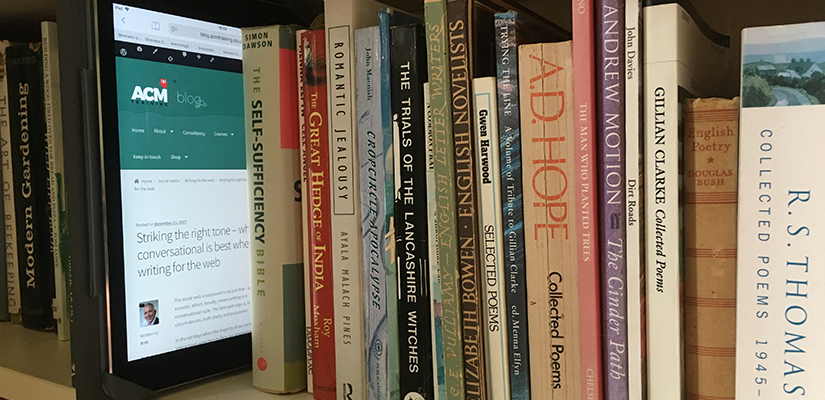
Well yes and no. Yes because the web provides writers with just another medium for their words. No because web users read in a different way to readers of text in other media such as newspapers, books and magazines. They read in a much less linear fashion flitting across the screen like a butterfly looking for something to settle on. And when they do settle they tend not to hang around for long if there’s nothing of interest – not least because just a few clicks away there’s the whole of the World Wide Web to distract them. So as a web writer first you’ve got to grab your readers’ attention, then you’ve got to hold them long enough for your words to work their magic. And if that wasn’t hard enough you’ve got very little space to do it – especially if your words are displayed on a tablet or smartphone.
If I viewed the preceding paragraph on my iPhone in landscape mode, in a font large enough to read without straining my eyes (Calibri 11 if you’re a real anorak and want to check for yourself) I ’d get halfway through the seventh line before having to…
…scroll down. As a rule of thumb – an ancient expression that seems oddly modern in an age of handheld devices – you can squeeze 120 words on a Smartphone. Tablets, laptops and desktops can, of course, accommodate progressively more in one “screenful”. Read this on your iPad in landscape mode and you’d get about as far as the word anorak in the second paragraph – a word count of about 200. Turn the screen through 90 degrees and you can squeeze in an extra hundred or so words – 330 in total. A figure not to be scoffed at in a world where Twitter limits you to 280 characters but still relatively few compared to the olde worlde of paper and ink.
Take the book that’s been gathering dust under my bed for so long it’s now more dust than book. It’s called The Isles – A History by Norman Davies. It contains approximately 450 words per page – twice that between page turns given that you get to see two pages at a time. How do I know this? Because I am that anorak! What’s more I’ve just counted 2,750 words on a double page spread in the best-selling tabloid newspaper and 3,056 words on a similar two pager in a leading broadsheet.
I’m not saying people won’t scroll down. I’m just saying that these differences between screen and page demand much of us as writers. Certainly we shouldn’t be putting really important stuff so deep into a webpage that people have to scroll down to find it because they simply may not bother. To avoid this problem we have to “front-load” web pages – that is, put the most critical information at the top of the page where it’s clearly visible. In the old days of broadsheet newspapers it was called putting stuff “above the fold” where, on a news stand, the bit of the article on the top half of the front page could instantly be seen by potential buyers.
Authors have long been aware of the need to keep readers reading over the potentially awkward chapter breaks. That’s why they often set up some kind of conflict towards the end of one chapter but keep the resolution from us until the beginning of the next. Done well the book becomes unputdownable. The challenge then is to make our websites unclickawayfromable!
[products limit=”4″ columns=”4″ skus=”wpid=63,wpid=109″]
